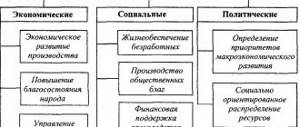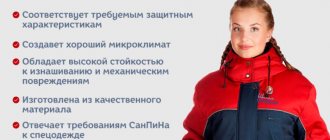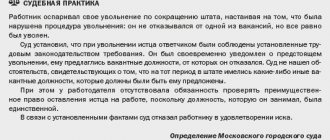Author of the article: Vladimir Danilevsky Last modified: January 2021 18481
Withholding for workwear upon dismissal is a legal practice of enterprises. The products are designed to protect workers from exposure to negative factors in the workplace. The completeness and properties of protective equipment may vary significantly depending on the field of human activity. At the same time, the current legislation clearly establishes the procedure for issuing items to subordinates and the process of returning them to the organization upon dismissal. The last procedure will be discussed in detail in the article.
Is the employer obligated to provide special clothing?
The manager is required by law to provide the subordinates of his enterprise with special clothing and personal protective equipment, especially if their work involves harmful substances and the work involves temperatures that are abnormal for the human body. The employer must comply with the standards for issuing PPE, since in connection with their violation he may be held liable.
Special clothing must be issued in a timely manner ; it is considered unacceptable for an employee to go to the workplace without appropriate protection. The person responsible for issuing PPE must take into account the worker's gender, clothing size and what type of work is expected.
If the employer for some reason does not provide special clothing, then the employee has the right to refuse to perform work that may be harmful to his health or threaten his life.
Who should receive PPE
Whatever the organization does, employees are required to receive special clothing. If this is a salesperson in a store, then this is a robe, an apron. Cleaners receive special gowns and gloves. And every employer is required by regulations and law to provide PPE.
By law, the employer provides workers with special clothing at his own expense. All employees of enterprises whose work involves difficult, dangerous or temperature conditions are required to be provided with PPE.
Based on the legislation, there are general and industry standards for the issuance of PPE.
- General standards apply to those workers whose positions are related to all sectors of the economy. These could be waiters, watchmen.
- Industry standards are specific to a particular organization. For example, a seamstress works in a consumer services organization, a cash collector in a bank, etc.
Model standards for the issuance of PPE serve to correctly determine to whom and what protective equipment to issue.
In cases where problems arise with the correct issuance of PPE, then workplace certification is carried out and it is determined what personal protective equipment should be used and provided to the employee.
Accounting for the receipt of workwear
According to the Methodological Guidelines in Accounting, workwear should be included in current assets. Unlike other types of special equipment, special clothing cannot be taken into account according to the standards of PBU 6/01 (clause 9 of the Guidelines). Thus, from now on, such strange fixed assets objects as workwear will not appear. But this applies only to the workwear that was purchased starting from 2003. If before this time any items of workwear were taken into account by the organization as part of fixed assets, they should be taken into account in the same order further, until the moment of disposal (write-off).
Workwear is accepted for accounting at its actual cost, which is the sum of the actual costs of its acquisition (manufacturing). The cost of workwear received at the warehouse is reflected in a separate subaccount “Workwear in the warehouse” to account 10 “Materials”.
Example 1
Silvia LLC purchased 100 work overalls for the amount of 36,000 rubles. (including VAT - 6,000 rubles). 1200 rubles were spent on the delivery of workwear. (including VAT - 200 rubles).
After posting the workwear to the warehouse, the accountant made the following entries:
- Debit 10 (sub-account “Workwear in warehouse”) Credit 60 30,000 rub. (36,000 rubles - 6,000 rubles) - reflects the purchase price of the purchased overalls;
- Debit 19 Credit 60 6000 rub. — the amount of VAT on purchased workwear is reflected;
- Debit 10 (sub-account “Workwear in warehouse”) Credit 60 1000 rub. (1200 rubles - 200 rubles) - the costs of delivery of purchased workwear are reflected;
- Debit 19 Credit 60,200 rub. — reflects the amount of VAT on delivery costs.
The Methodological Instructions stipulate the case when special clothing is not owned by an organization, but is transferred to it for use or disposal. Of course, it is difficult to imagine such a situation in practice. And yet, let us take into account that “foreign” workwear should be taken into account on off-balance sheet accounts in a valuation agreed upon with its owner.
If an organization uses workwear of its own production, the costs of its production are first grouped in the production cost accounts. Then, when the workwear is manufactured, its actual cost is calculated, taking into account direct and indirect costs. Finished workwear is delivered to the warehouse. Accounting for manufactured workwear will be reflected in the following entries:
- Debit 20 (23) Credit 10 (69, 70) reflects the costs of manufacturing workwear;
- Debit 10 (subaccount “Workwear in warehouse”) Credit 20 (23) manufactured workwear was transferred to the warehouse.
Most often, self-made workwear is used by organizations that produce it for the purpose of sale. In this case, the manufactured workwear is first accounted for in account 43 “Finished products”. Then the cost of workwear intended for own consumption is written off to account 10, and the cost of workwear sold externally is reflected in account 90 “Sales”:
- Debit 20 (23) Credit 10 (69, 70) reflects the costs of manufacturing workwear;
- Debit 43 Credit 20 (23) reflects the cost of finished workwear;
- Debit 10 (subaccount “Workwear in warehouse”) Credit 43 reflects the cost of workwear intended for issue to employees;
- Debit 90-2 Credit 43 the cost of workwear was written off upon its sale.
In tax accounting, the actual cost of workwear is formed in the same way as in accounting - based on supplier prices, delivery costs and other expenses associated with its acquisition, without taking into account the amounts of taxes subject to deduction or inclusion in expenses (clause 2 of Art. 254 and paragraph 1 of Article 257 of the Tax Code of the Russian Federation). Workwear manufactured by the organization itself is assessed as a finished product according to the standards of Art. 319 of the Tax Code of the Russian Federation. But if in accounting all workwear is included in current assets, then for tax accounting purposes it is divided into two groups. Workwear worth more than 20,000 rubles. and with a useful life of more than 12 months is recognized as depreciable property (clause 1 of Article 256 of the Tax Code of the Russian Federation). Working clothes that are not included in the depreciable property are included in material expenses (clause 3, clause 1, article 254 of the Tax Code of the Russian Federation).
This discrepancy between the accounting and tax accounting of workwear, which has appeared since 2003 thanks to the new Methodological Instructions, “pulls” with it all further differences in the accounting and tax accounting of operations with workwear.
The legislative framework
Taking into account the legislative framework, which consists of the Labor Code of the Russian Federation, the employer is obliged to provide employees with PPE and at the same time comply with standard standards for issuing workwear:
- The workwear meets quality certificates.
- The employer, at his own expense, provides workers whose work involves harmful and dangerous working conditions with personal protective equipment.
- Properly organize the issuance and use of PPE.
In turn, workers must also comply with the requirements of the Labor Code of the Russian Federation and properly handle workwear. If his or a co-worker’s condition is poor, the worker is obliged to inform the employer about it. All life-threatening situations are also reported to the supervisor.
There are quite a lot of cases where accidents occur at work due to the fault of workers themselves who neglect to use PPE. Therefore, there was a need to legally oblige workers to use protective clothing correctly.
Specifics of legislation
Standard norms for issuing workwear are, as a rule, contained in legal acts issued by executive authorities. For example, similar provisions are in Order of the Ministry of Health and Social Development No. 541n dated October 1, 2008. This legal act approved standard standards for the issuance of free workwear and other types of PPE for workers employed in through production areas, as well as in areas characterized by hazardous conditions labor, and in workplaces with increased pollution or special temperature environments. This document contains a list of types of clothing and personal protective equipment, as well as the norms for their issuance for the year. The names of working professions, which are included in the legal act establishing standard standards for the free issuance of workwear, are taken from various sources. These are mainly qualification reference books containing classifications of positions and professions.
The provisions defining the order in which PPE must be issued to employees are enshrined in the Rules for Providing Employees with Work Clothing and PPE. In particular, it says that specialists in those professions that provide for standard standards for the issuance of workwear, PPE and other items are issued regardless of whether their specific position is included in qualification reference books and other industry regulations.
The Ministry of Social Development may also issue other regulations regulating the procedures for employers to issue free work clothing to employees. For example, these could be Orders regulating relevant activities in a specific area - housing and communal services, water management, construction, mining, metallurgy, oil and gas complex, etc.
When determining obligations to issue PPE and workwear for an employer, it is not so much the profession that is of decisive importance, but rather the actual production conditions. For example, if we are talking about a chemical enterprise, then in any case standards will be established for the issuance of protective clothing for drivers, welders, mechanics, crane operators - all those who are employed in areas characterized by a hazardous environment or special temperatures. However, laws may define specific types of PPE and workwear that are optimized for use by specialists in specific positions. For example, standards for issuing protective clothing for drivers in the food industry require that workers be equipped with signal suits, hats, insulated vests and jackets, leather boots, and gloves coated with polymer. In turn, for workers operating vehicles in the electric power industry, the relevant standards may predetermine the need to issue raincoats for water protection, felt boots, and special suits.
It may be noted that the rules regarding the supply of workers with special clothing are the prerogative of not only Russian legislation, but also of other countries. Legal acts similar in many legal areas are in force, for example, in Belarus. The standards for issuing workwear in the Republic of Belarus, in general, are determined according to the same principles as in the Russian Federation. Employees of Belarusian enterprises in areas where hazardous production is expected should receive the necessary protective equipment free of charge.
PPE certification
Before purchasing PPE, the employer of the enterprise must make sure that the workwear has the appropriate quality certificate. The certification process ensures that PPE is safe for human use and can be used for human protection and safety.
According to the Labor Code of the Russian Federation, it is the employer who is obliged to provide workers with safe working conditions. And therefore he is responsible for the acquisition and issuance of safe protective equipment.
In addition to having a certificate for PPE, when purchasing workwear, the employer must check the expiration date, which is also confirmed by the corresponding certificate.
All workwear must comply with GOST standards.
Terms of reference for the purchase of workwear
The TOR sets out the basic requirements for the purchased goods and delivery conditions.
It is recommended to include in the document:
- description of workwear (you can indicate a sketch, image, drawing of the product);
- characteristics (quality parameters, quantity, sizes, etc. Requirements must be objective, understandable, consistent);
- packaging requirements;
- Estimated delivery time;
- guarantee period;
- requirement for certificates of conformity;
- links to used documents on standardization and technical regulation.
Types of standards
The issuance of protective clothing at enterprises is controlled by government agencies. It is especially important to comply with the issuance rules at those enterprises where there is an increased risk of working with harmful and dangerous substances, as well as temperature conditions. Products that are designed to protect workers have appropriate standards.
Their variety is very large.
An example of some types of standards for PPE:
- Safety glasses . Serve to provide visual protection. Produced in accordance with GOST R12.4.013-97. This type of PPE can protect your eyes from any damage.
- Overalls. This includes all personal protective equipment that can be used in industry, production, namely vests, gowns, suits, etc.
- Protective clothing for hands. These are all types of gloves - rubber, cotton, which protect hands from exposure to harmful agents. As well as thermal or chemical damage.
- Shoes. Provides protection to the lower extremities. Large industries often use vibration-proof shoes that reduce vibration, which helps eliminate discomfort when walking.
Required documents
When an employee gets a job, he must read the employment contract, which specifies the rules and regulations under which PPE will be issued.
The document that displays the issuance of PPE contains information about the worker, his personal data, profession or position. Next, information about PPE is written down, when and in what quantity it was received, as well as the period of their use.
Information about the issuance of workwear can also be displayed in the worker’s personal card.
Issuance of workwear and write-off of its cost
Workwear received at the warehouse is issued to employees in accordance with the standards and internal orders of the organization’s management. Accounting for issued workwear is carried out at its actual cost. The issue of workwear is reflected by internal posting in account 10:
- Debit 10 (subaccount “Workwear in operation”) Credit 10 (subaccount “Workwear in warehouse”) reflects the cost of workwear issued to employees.
The accountant must organize proper analytical accounting of workwear transferred into operation. For example, you can draw up turnover sheets. They should indicate the name, quantity and actual cost of the issued workwear, the date of entry into service and the date of return, the workshop and department where the workwear is used, and the financially responsible persons.
In accounting, the cost of workwear is written off in two ways: at a time or using the straight-line method.
The one-time write-off method can be applied to workwear, the period of use of which, according to the issuance standards, does not exceed 12 months. With this method, the cost of workwear is completely written off as expenses at the time it is put into operation.
The straight-line method is used to write off the cost of workwear with a service life of more than a year. With this method, the cost of workwear items is repaid evenly over their useful life, as provided for in standard industry standards.
Please note: using the method of one-time write-off of short-lived workwear is the right, but not the obligation of the organization. By decision of management, the cost of workwear with a wear life of less than a year can be repaid using the straight-line method.
Example 2
Employees of Dormekhanizatsiya CJSC were given the following from the warehouse for use:
- 10 safety helmets costing 216 rubles. per piece (wearing period - 2 years);
- 14 work suits costing 250 rubles. per piece (wearing period - 9 months);
- 28 pairs of canvas mittens worth 50 rubles. per pair (wearing period - 2 months).
The cost of workwear with a standard use period of more than a year is written off in the organization on a straight-line basis.
The accountant made the following entries:
- Debit 10 (sub-account “Workwear in use”) Credit 10 (sub-account “Workwear in warehouse”) 7060 rub. (216 rub. x 10 pcs. + 250 rub. x 14 pcs. + 50 rub. x 28 pairs) - reflects the cost of workwear issued to employees;
- Debit 20 Credit 10 (sub-account “Working clothes in use”) 4900 rub. (250 rub. x 14 pcs. + 50 rub. x 28 pairs) - the cost of work suits and mittens is written off as expenses;
- Debit 20 Credit 10 (sub-account “Working clothes in use”) 90 rub. (216 rub. x 10 pcs.: 24 months) - part of the cost of protective helmets is written off as expenses (posting is done monthly for two years).
In tax accounting, the write-off of the cost of workwear is carried out differently. Workwear costing less than 20,000 rubles. and with a useful life of less than a year are included in material costs. The costs of its acquisition are recognized as indirect expenses and are subject to a one-time write-off at the time of its issuance to employees (clause 2 of Article 318 of the Tax Code of the Russian Federation). Workwear costing more than 20,000 rubles. and with a service life of more than 12 months is included in depreciable property. Its cost is repaid by depreciation, which is calculated by one of two methods - linear or non-linear (clause 1 of article 259 of the Tax Code of the Russian Federation).
The methods for writing off the cost of workwear provided for by the Tax Code and the Methodological Instructions do not coincide in all respects (see table).
How the cost of workwear is written off in accounting and tax accounting
| Cost and useful life of workwear | Accounting | Tax accounting | ||
| one-time write-off | write-off using the straight-line method | one-time write-off | depreciation using linear or non-linear method | |
| Less than 20,000 rub. and less than a year | + | + | ||
| Less than 20,000 rub. and more than a year | + | + | ||
| More than 20,000 rub. and less than a year | + | + | ||
| More than 20,000 rub. and more than a year | + | + | ||
The table shows that in accounting and tax accounting since 2003, it will be necessary to write off differently workwear, the cost of which is less than 20,000 rubles, and the wearing period according to the norms exceeds 12 months. In tax accounting, the cost of such workwear is immediately included (at the time of issue) as material expenses, but in accounting it will have to be written off gradually.
Employers must not only provide workers with protective clothing, but also bear the cost of keeping it clean and in good condition. In accounting, costs for cleaning, washing, repairing, disinfecting work clothing and other measures for its maintenance are included in expenses for ordinary activities (clause 29 of the Methodological Instructions). For tax accounting, these costs are recognized as current expenses. They are accepted as a reduction in the tax base in the reporting period when the corresponding transaction was carried out (clause 1 of Article 260, clause 2 of Article 318 of the Tax Code of the Russian Federation).
After the wearing period expires, workers return the workwear to the warehouse. There is no need to make any entries in the accounting accounts, since the cost of the workwear by the time of return has already been completely written off as expenses. The necessary notes on the return of worn-out workwear are made only in analytical turnover sheets, as well as in warehouse documents and personal cards of employees.
What if an employee returns workwear to the warehouse because he no longer needs it? For example, upon dismissal, when changing the nature of the job. Then it is necessary to make entries not only in warehouse documents and analytical statements, but also in accounting accounts. Internal postings to account 10 must show the residual (underwritten) cost of the returned workwear:
- Debit 10 (subaccount “Workwear in warehouse”) Credit 10 (subaccount “Workwear in use”) reflects the residual value of workwear returned to the warehouse.
Care of workwear
Since PPE is the property of the employer, it is his responsibility to ensure cleaning and maintenance of the workwear. To do this, the enterprise must have appropriate dry cleaners. If this is not possible at the enterprise itself, the employer enters into an agreement with contractors who are responsible for the removal and cleaning of workwear.
It is also the employer’s responsibility to ensure that PPE is properly stored so that it does not lose its functionality. The enterprise must provide the employee with spare sets of protective clothing while the contaminated protective equipment is being dry-cleaned or washed.
Procurement restrictions
If you intend to purchase goods with code 14.12.30 (other workwear), then the documentation must establish a ban on the admission of foreign-made products. The exceptions are the EAEU countries: Armenia, Belarus, Kazakhstan, Kyrgyzstan. Employers can purchase workwear of a certain type from foreign companies only when its production has not been established in the listed states. The requirements for procurement participants must specify that materials from the EAEU countries must be used in production. There may also be a need to give preference to disability organizations.
Terms of use
When applying for a job that involves the use of PPE, the employer must have a conversation with the future employee about the rules for using protective clothing. Not every person knows and can understand how to dress or what the main functions of PPE are.
If possible, enterprises hold master classes or other events where workers learn and practice using PPE correctly.
This is also necessary so that the employee can independently determine the serviceability of protective equipment, such as a gas mask. Had an idea of why you need to wear or use PPE. And also after such instruction, the employee will have to sign in the journal with a note that he is familiar with the rules of conduct with workwear.
Special clothing for reception or transfer
As has already been said, it is the employer who is obliged to provide workers with special clothing when they get a job. The same applies when an employee combines work or is transferred to another job.
- Combination of works . In the case of combining several jobs at an enterprise or professions, the employer, in addition to basic workwear, must also provide other types of PPE that are suitable for a particular type of work. This is carried out according to the criteria established for industry issuance standards or improved standards.
- Translation. If an employee is transferred to another position or if he undergoes professional training (student internship), then PPE is issued temporarily.
Documentary support
It is interesting to consider such an aspect as document flow in the process of the employer’s implementation of the provisions of the law that determine the standards for issuing free workwear. Work with certain documents in the process of providing employees of companies with PPE begins already when signing an employment contract. At the appropriate stage of formalizing relations with a specialist, the employer must familiarize the new employee with the rules and regulations governing the issuance of workwear.
Also, the document flow, the need for which is determined by the standards for issuing protective clothing to employees, implies that the employer will create a register of processions and positions for which PPE must be issued. This is usually a corporate document that reflects relevant information. It should specify the procedure within which PPE will be issued, used and stored. The structure of the document in question may look something like this: a list of professions and positions is created, and opposite each - the terms for using PPE and workwear, the number of copies of the products that the employee should receive, as well as the frequency of their issuance.
| Full name | Job title | Type of workwear | Quantity | Term of use |
| Ivanov Stepan Alexandrovich | steel worker | Protective suit | 1 | 3 months |
The structure of the table, of course, can be completely different, this is an approximate example. The standards for issuing workwear must contain criteria that provide for no less regular replacement during the year than is required according to the Regulations of the Ministry of Health and Social Development. But it is quite possible to improve the standards provided for by law, if the financial situation of the employing company allows this to be done. Corporate standards for the free issuance of workwear and safety footwear can be reflected in appendices to the collective labor agreement or as a separate act. Information that such and such type of personal protective equipment was issued is entered into the corresponding personal card of the employee.
If the employer establishes improved standards for the issuance of safety footwear and workwear, then information about this must be recorded in the collective agreement. At the same time, standard criteria recommended by law are indicated, which have been improved at the company’s initiative. The fact that a particular PPE was issued to an employee must be confirmed by the signature of a specialist. The workwear must be issued by a labor safety instructor or another competent employee of the employing company.
Workwear and safety footwear are issued to employees on a rental basis; they remain the property of the company. If a person is fired or transferred to a position that, according to legal criteria, does not require the wearing of protective clothing and the use of PPE, then the corresponding products must be returned to the employer.
Responsibility of workers and employers
- Responsibility of workers towards personal protective equipment. Each employee must properly treat the workwear issued to him. If he spoils it, then the money spent on the purchase of protective equipment is withheld from wages. If PPE becomes unusable through no fault of the worker, then the employer must issue new protective clothing. An employee has the right to refuse to perform dangerous work if he is not provided with PPE or if it does not meet the standards. Employees do not have the right to remove personal protective equipment from the territory of the enterprise, since it is the property of the employer. In the event of a PPE malfunction, the employer must be informed. And issue new PPE as soon as possible.
- Employer's responsibility to PPE. Based on established laws, the employer is obliged to provide workers with workwear that must comply with quality certificates. In case of violations of standard standards for issuing PPE, the employer may be held liable.
So:
- If work at an enterprise involves hazardous substances, then people are provided with PPE. Moreover, the employer must provide workers with special clothing.
- The employer is responsible for quality PPE, which purchases and checks for defects in workwear.
- Before starting work, the employee must undergo training on the rules of conduct with workwear and its use.
- The employee, as well as the employer, is responsible for workwear.
- PPE is considered the property of the enterprise and therefore can only be rented by the employee.
- A worker may refuse to perform hazardous work if he or she has not been provided with PPE.
Article 221 of the Labor Code of the Russian Federation. Providing workers with personal protective equipment (current version)
Standard standards for the free issuance of special clothing, special footwear and other personal protective equipment to chemical production workers engaged in work with harmful and (or) dangerous working conditions, as well as work performed in special temperature conditions or associated with pollution (Order of the Ministry of Health and Social Development of Russia dated 08/11/2011 N 906n);
Standard standards for the free issuance of special clothing, special footwear and other personal protective equipment to workers engaged in work with harmful and (or) dangerous working conditions, as well as work performed in special temperature conditions or associated with pollution (Order dated June 22, 2009 N 357n);
Model standards for the free issuance of special clothing, special shoes and other personal protective equipment to communication workers engaged in work with harmful and (or) dangerous working conditions, as well as work performed in special temperature conditions or associated with pollution (Order dated June 18, 2010 N 454n);
Standard standards for the free issuance of special clothing, special footwear and other personal protective equipment to employees of electric power industry organizations engaged in work with harmful and (or) dangerous working conditions, as well as work performed in special temperature conditions or associated with pollution (Order dated April 24 .2011 N 340n) and others.
3. Mandatory requirements for the acquisition, issuance, use, storage and care of special clothing, special footwear and other personal protective equipment are established by the Intersectoral Rules for Providing Workers with Special Clothing, Special Footwear and Other Personal Protective Equipment, approved. By order of the Ministry of Health and Social Development of Russia dated 06/01/2009. N 290n.
The requirements of these Rules apply to employers - legal entities and individuals, regardless of their legal forms and forms of ownership.
Workers in cross-cutting professions and positions in all sectors of the economy are issued personal protective equipment in accordance with standard standards, regardless of the organizational and legal forms and forms of ownership of the employer, as well as the presence of these professions and positions in other standard standards (clause 14). For example, a battery worker working in a road transport organization must be issued personal protective equipment in accordance with the Standard Standards for the free issuance of certified special clothing, special footwear and other personal protective equipment to employees of cross-cutting professions and positions in all sectors of the economy engaged in work with hazardous and (or) hazardous working conditions, as well as work performed in special temperature conditions or associated with pollution, approved. By Order of the Ministry of Health and Social Development of Russia dated October 1, 2008 N 541n. A battery worker engaged in underground mining operations (mines) in the mining industry must be issued personal protective equipment in accordance with the Standard Standards for the free issuance of certified special clothing, special footwear and other personal protective equipment to workers in the mining and metallurgical industry and metallurgical production of other industries employed at work with harmful and (or) dangerous working conditions, as well as at work performed in special temperature conditions or associated with pollution, approved. By Order of the Ministry of Health and Social Development of Russia dated December 25, 2006 N 873.
Foremen, foremen performing the duties of foremen, assistants and assistant workers, whose professions are indicated in the relevant standard standards, are issued the same personal protective equipment as workers in the corresponding professions (clause 15). The personal protective equipment for workers, specialists and other employees provided for in the standard standards is issued to these employees even if they are senior by profession and position and directly perform the work that gives them the right to receive these personal protective equipment (clause 16) .
Workers who combine professions or constantly perform combined work, including as part of complex teams, in addition to the personal protective equipment issued to them for their main profession, are additionally issued, depending on the work performed, other types of personal protective equipment provided for by the relevant standard standards for the combined profession ( according to the combined type of work).
Employees temporarily transferred to another job, employees and other persons undergoing vocational training (retraining) in accordance with an apprenticeship contract, pupils and students of educational institutions of primary, secondary and higher vocational education while undergoing practical training (on-the-job training), masters of industrial training , as well as other persons participating in the employer’s production activities or carrying out control (supervision) measures in the established field of activity in accordance with current legislation, personal protective equipment is issued in accordance with standard standards and Inter-industry rules for providing workers with special clothing, special footwear and other personal protective equipment for the duration of this work (undergoing vocational training, retraining, industrial practice, industrial training) or carrying out control (supervision) measures.
The employer is obliged to ensure that employees are informed about the personal protective equipment they are entitled to. When concluding an employment contract, the employer must familiarize employees with the Intersectoral Rules for Providing Employees with Special Clothing, Special Footwear and Other Personal Protective Equipment, as well as with the standard standards for issuing personal protective equipment corresponding to his profession and position.
Personal protective equipment provided to employees must be appropriate to their gender, height, size, as well as the nature and conditions of the work they perform. The issuance of personal protective equipment to employees, including foreign production, as well as special clothing held by the employer for temporary use under a lease agreement, is permitted only if there is a certificate or declaration of conformity confirming the compliance of the issued personal protective equipment with the safety requirements established by law, and also the presence of a sanitary-epidemiological report or a certificate of state registration of dermatological personal protective equipment, issued in the prescribed manner. The acquisition (including under a lease agreement) and issuance to employees of personal protective equipment that does not have a declaration of conformity and (or) a certificate of conformity or that has a declaration of conformity and (or) a certificate of conformity that has expired is not permitted.
The employer has the right, taking into account the opinion of the elected body of the primary trade union organization or another representative body authorized by employees, to replace one type of personal protective equipment provided for by the standard standards with a similar one that provides equivalent protection from dangerous and harmful production factors. For example, a cotton overall can be replaced with a cotton suit or robe and vice versa, leather boots (low boots) with rubber or tarpaulin boots and vice versa, a rubberized apron with an apron made of polymer materials and vice versa, mittens with gloves and vice versa, rubber gloves with gloves made of polymer materials and vice versa, gloves - with heat-resistant gloves made of synthetic material and vice versa, plastic oversleeves - with oversleeves made of polymer materials and vice versa.
In cases where such personal protective equipment as a signal vest, a safety harness, a restraint harness (safety belt), dielectric galoshes and gloves, a dielectric mat, safety glasses and shields, filtering personal respiratory protection equipment with anti-aerosol and anti-gas filters, insulating personal respiratory protection equipment, protective helmet, balaclava, mosquito net, hard hat, shoulder pads, elbow pads, self-rescuers, headphones, anti-noise inserts, light filters, vibration-proof mittens or gloves, etc. are not specified in the relevant standard standards, they can be issued to employees with a wear period “until wear” based on the results of certification of workplaces for working conditions or a special assessment of working conditions, as well as taking into account the conditions and characteristics of the work performed. The specified personal protective equipment is also issued based on the results of certification of workplaces for working conditions or a special assessment of working conditions as duty equipment (for periodic use when performing certain types of work). At the same time, anti-noise liners, balaclavas, as well as personal respiratory protection equipment, which do not allow for repeated use and are issued as “duty” ones, are issued in the form of a disposable kit before the work shift in an amount corresponding to the number of employees at a given workplace.
Duty personal protective equipment for general use is issued to employees only for the duration of the work for which they are intended. These personal protective equipment, taking into account the requirements of personal hygiene and the individual characteristics of workers, are assigned to certain workplaces and transferred from one shift to another.
Personal protective equipment intended for use in special temperature conditions caused by annual seasonal temperature changes (warm special clothing and warm special shoes, for example suits, jackets and trousers with insulated lining, fur suits, sheepskin coats, hats with ear flaps, fur mittens, felt boots) are issued to employees at the beginning of the corresponding period of the year, and at the end of this period are handed over to the employer for organized storage until the next season. The time for using these types of personal protective equipment is set by the employer, taking into account the opinion of the elected body of the primary trade union organization or other representative body of workers and local climatic conditions.
The employer is obliged to organize proper accounting and control over the issuance of personal protective equipment to employees within the established time frame. The issuance and handing over of personal protective equipment to employees is recorded by an entry in the personal record card for the issuance of such equipment. The employer has the right to keep records of the issuance of personal protective equipment to employees using software (information and analytical databases).
When issuing special clothing to an employee, rented by the employer, the employee is assigned an individual set of personal protective equipment, for which the appropriate marking is applied to it. Information about the issuance of this kit is entered into the employee’s personal record card and issuance of personal protective equipment.
Workers must treat the personal protective equipment received with care and notify the employer (or his representative) about the failure (malfunction) of personal protective equipment.
The period for using personal protective equipment is calculated from the date of actual issue to employees. The wearing period of personal protective equipment used in special temperature conditions includes the time of their organized storage.
Personal protective equipment returned by employees after their wearing period has expired, but is suitable for further use, is used for its intended purpose after taking measures to care for it (washing, cleaning, disinfection, degassing, decontamination, dust removal, neutralization and repair). The suitability of the specified personal protective equipment for further use, the need for and composition of measures to care for them, as well as the percentage of wear of personal protective equipment are established by an official authorized by the employer or the labor protection commission of the organization (if any) and are recorded in a personal record card for the issuance of personal protective equipment protection.
In the event of loss or damage to personal protective equipment in designated storage areas for reasons beyond the control of employees, the employer provides them with other serviceable personal protective equipment. The employer provides replacement or repair of personal protective equipment that has become unusable before the end of the wearing period for reasons beyond the control of the employee.
Workers must correctly use the personal protective equipment provided to them. The obligation to ensure the mandatory and correct use of personal protective equipment issued to them by employees rests with the employer.
When issuing personal protective equipment, the use of which requires practical skills from workers (respirators, gas masks, self-rescuers, safety belts, mosquito nets, helmets, etc.), the employer ensures that workers are instructed on the rules for using these personal protective equipment, the simplest ways to check their performance and serviceability, and also organizes training on their use.
In addition, in accordance with the deadlines established in national standards, the employer must ensure testing and inspection of the serviceability of personal protective equipment, as well as timely replacement of their parts with reduced protective properties. After checking the serviceability, a mark (stamp, stamp) is placed on the personal protective equipment indicating the timing of the next test.
Workers should not be allowed to perform work without personal protective equipment issued to them in the prescribed manner, as well as with faulty, unrepaired or contaminated personal protective equipment.
4. The employer is given the right, taking into account the opinion of the elected body of the primary trade union organization or other representative body of workers and its financial and economic situation, to establish standards for the free issuance of special clothing, special shoes and other personal protective equipment to employees, which improve the protection of workers from existing in the workplace, harmful and (or) dangerous factors, as well as special temperature conditions or pollution. These standards are approved by local regulations of the employer based on the results of certification of workplaces for working conditions or a special assessment of working conditions and taking into account the opinion of the relevant trade union or other body authorized by employees and can be included in a collective and (or) labor agreement indicating standard standards, according to Compared to which, the provision of workers with personal protective equipment is improved.
5. The employer, at his own expense, is obliged to ensure proper storage and care of personal protective equipment: timely dry cleaning, washing, degassing, decontamination, disinfection, neutralization, dust removal, drying, as well as repair and replacement of personal protective equipment. For these purposes, the employer has the right to issue employees with two sets of appropriate personal protective equipment with double the wearing period.
To store personal protective equipment issued to employees, the employer provides specially equipped premises (dressing rooms) in accordance with the requirements of building codes and regulations. At the same time, at the end of the working day, employees are prohibited from taking personal protective equipment outside the territory of the employer or the territory where work is carried out by the employer - an individual entrepreneur. In some cases, when, due to working conditions, the specified procedure cannot be followed (for example, in logging, geological work), personal protective equipment remains with employees during non-working hours.
Depending on working conditions, the employer (in its structural divisions) installs dryers, chambers and installations for drying, dust removal, degassing, decontamination and neutralization of personal protective equipment. If the employer does not have the technical capabilities for dry cleaning, washing, repair, degassing, decontamination, neutralization and dust removal of personal protective equipment, these works are performed by an organization engaged by the employer under a civil contract.
6. Monitoring compliance by employers (legal entities and individuals) with Intersectoral Rules for providing workers with special clothing, special footwear and other personal protective equipment in subordinate organizations is carried out in accordance with Art. Art. 353 and 370 of the Labor Code by federal executive authorities, executive authorities of constituent entities of the Russian Federation and local governments, as well as trade unions, their associations and technical labor inspectors under their jurisdiction and authorized (trusted) persons for labor protection.
If an employee is not provided with personal protective equipment in accordance with established standards, the employer does not have the right to demand that he perform his job duties and is obliged to pay for the downtime that arises for this reason (Part 6 of Article 220 of the Labor Code). For payment for downtime, see comment. to Art. 157 TK.
7. Workers engaged in work with unfavorable working conditions must be provided with some other means of protection from the effects of negative production factors. Thus, for work involving pollution, workers are provided with free soap or liquid detergents. For work involving hard-to-remove persistent contaminants (oils, greases, petroleum products, varnishes, paints, resins, glue, bitumen, fuel oil, silicone, soot, graphite, various types of industrial dust), cleaning creams, gels and pastes are provided. When working with organic solvents, technical oils, disinfectants, solutions of cement, lime, acids, alkalis, salts, etc., when working with rubber gloves or gloves made of polymer materials, as well as in case of negative environmental influences, regenerating, restorative creams, emulsions.
Providing workers with flushing and (or) neutralizing agents, incl. foreign production is allowed only if their compliance with state regulatory requirements is confirmed by a declaration of conformity and (or) a certificate of conformity, issued in the manner prescribed by current legislation.
A unified list of products subject to mandatory certification and a unified list of products, confirmation of conformity of which is carried out in the form of a declaration of conformity, were approved by Decree of the Government of the Russian Federation of December 1, 2009 N 982.
The establishment of labor safety standards and standard norms for the free issuance of flushing and (or) neutralizing agents to workers is within the powers of the Russian Ministry of Labor (clauses 5.2.28 and 5.2.32 of the Regulations on the Ministry of Labor and Social Protection of the Russian Federation, approved by the Decree of the Government of the Russian Federation dated 06/19/2012 N 610). The labor safety standard “Providing workers with flushing and (or) neutralizing agents” (hereinafter referred to as the Standard) and the Standard standards for the free provision of flushing and (or) neutralizing agents to employees were approved by Order of the Ministry of Health and Social Development of Russia dated December 17, 2010 N 1122n.
The standard establishes the rules for the acquisition, issuance, use and organization of storage of flushing and (or) neutralizing agents. It applies to employers - legal entities and individuals, regardless of their legal forms and forms of ownership.
The standards for issuing flushing and (or) neutralizing agents that correspond to the working conditions at the employee’s workplace are specified in the employee’s employment contract (clause 9).
When issuing flushing and (or) neutralizing agents, the employer is obliged to inform employees about the rules for their use, and employees are obliged to use the products issued to them for their intended purpose and in accordance with the Standard (clauses 10, 11).
The list of workplaces and the list of employees for whom the issuance of flushing and (or) neutralizing agents is necessary is compiled by the labor protection service (labor safety specialist) or another authorized structural unit (official) of the employer and approved by the employer, taking into account the opinion of the elected body of the primary trade union organization or other representative body authorized by employees. The specified list of workplaces and the list of employees are formed on the basis of the Standard Standards and in accordance with the results of certification of workplaces for working conditions or a special assessment of working conditions, taking into account the features of the existing technological process and labor organization, the raw materials used.
Before the employer receives the results of a special assessment of working conditions, or if the employer does not have them, a list of workplaces and a list of employees for whom the issuance of flushing and (or) neutralizing agents is necessary is formed taking into account the opinion of the elected body of the primary trade union organization or another representative body authorized by employees based on the Model Standards.
Standard standards for the free distribution of flushing and (or) neutralizing agents to employees are given in Appendix No. 1 to Order of the Ministry of Health and Social Development of Russia dated December 17, 2010 No. 1122n. So, for example, in work involving easily washable contaminants, the norm per employee per month is 200 g of toilet soap or 250 g of liquid detergents in dispensing devices. When working in coal (shale) mines, in open pit mines, in processing and briquette factories, in mine construction and mine installation organizations in the coal industry, the dispensing rate is 800 g of toilet soap or 750 ml of liquid detergents in dosing devices. The norms for issuing regenerating, restorative creams, emulsions are 100 ml; cleansing cream, gel, paste - 200 ml.
Responsibility for the timely and full issuance of flushing and (or) neutralizing agents to employees in accordance with the Model Standards, for organizing control over the correct use of them by employees, as well as for storing flushing and (or) neutralizing agents is assigned to the employer (his representative) (p 26 of the Standard).










